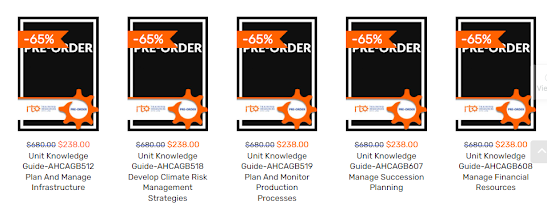Unlocking Success: A Comprehensive Guide to Developing Assessment Tools and Purchasing Readily Made Tools for RTO Training Resources
In the dynamic landscape of Registered
Training Organisations (RTOs), the development of effective assessment tools is
crucial for ensuring quality training outcomes. Whether you're a seasoned
education professional or a budding trainer, this guide aims to demystify the
process of creating assessment tools while also exploring the option of
purchasing readily made tools. We'll delve into key considerations and shed
light on the importance of Units of Competency in Training Packages.
Developing Assessment Tools: A Roadmap
to Success
1.
Understanding the Basics -
Before embarking on the journey of developing assessment tools, it's imperative
to grasp the basics. Familiarise yourself with the specific Units of Competency
relevant to your training context. These units serve as the building blocks for
crafting targeted and comprehensive assessments.
2.
Mapping Outcomes - Effective
assessments align seamlessly with the learning outcomes specified in the Units
of Competency. Mapping out these outcomes ensures that your assessment tools
are not only relevant but also contribute directly to the development of
essential skills and knowledge.
3.
Tailoring to Learner Needs -
One size does not fit all. Consider the diverse needs of your learners when
creating assessment tools. Incorporate a variety of assessment methods, such as
practical demonstrations, written tasks, and project work, to cater to
different learning styles and preferences.
4.
Ensuring Fairness and Validity
- Fairness and validity are the cornerstones of credible assessments. Ensure
that your tools are fair by avoiding bias and discrimination. Additionally,
validate the assessment process by regularly reviewing and updating your tools
to reflect industry changes.
5.
Engaging Stakeholders -
Collaboration with industry experts, trainers, and learners is invaluable in
the assessment development process. Seek feedback to refine your tools and
ensure they meet the evolving needs of both the industry and learners.
Purchasing Readily Made Tools: A
Time-Saving Solution
1.
Exploring RTO Training
Resources - As you navigate the landscape of assessment tools, consider the
option of purchasing readily made tools from trusted sources. RTO Training
Resources offers a diverse range of pre-developed assessment tools,
streamlining the process and saving you valuable time.
2.
Quality Assurance - When opting
for pre-made tools, quality assurance is paramount. Ensure that the purchased
assessments align with the specific Units of Competency and meet the quality
standards set by regulatory bodies.
3.
Customisation Options - While
purchasing ready-made tools provides a time-saving advantage, the ability to
customise assessments to suit your RTO's unique requirements is equally
important. Look for resources that offer flexibility for adaptation.
Key Considerations to Keep in Mind
1.
Compliance with Standards -
Adherence to regulatory standards is non-negotiable in the education sector.
Whether developing assessments from scratch or purchasing them, confirm that
they comply with the Standards for Registered Training Organisations (RTOs) to
maintain the integrity of your training programs.
2.
Currency and Relevance - The
vocational education landscape is ever-evolving. Regularly review and update
your assessments to ensure they remain current and relevant to industry
standards.
3.
Continuous Improvement - The
journey doesn't end with the development or purchase of assessment tools.
Implement a robust feedback and improvement cycle to continuously enhance the
effectiveness of your assessments.
The development and selection of assessment
tools are pivotal aspects of the RTO journey. Whether crafting bespoke
assessments or opting for ready-made solutions, a thorough understanding of
Units of Competency and a commitment to quality are essential. By following
this comprehensive guide, you're well on your way to unlocking success in the
realm of RTO training resources.




Comments
Post a Comment